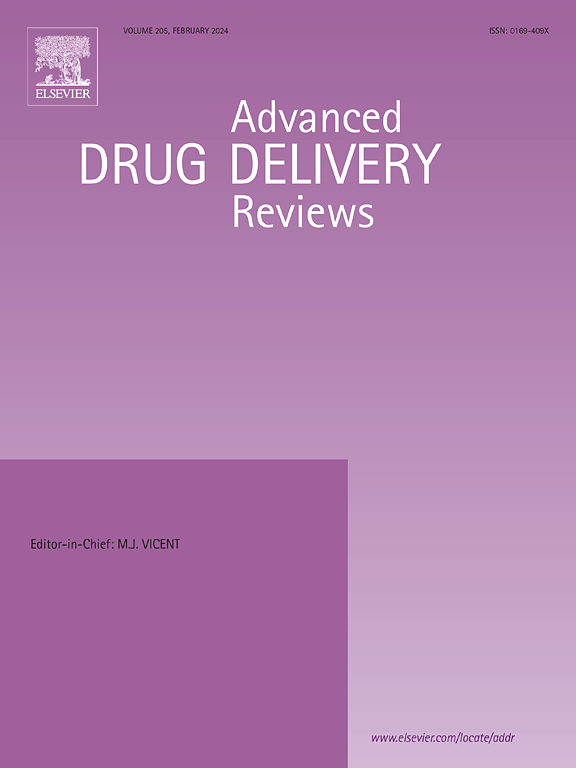CRISPR/Cas生物成像:从全身生物分布到单细胞动力学
IF 17.6
1区 医学
Q1 PHARMACOLOGY & PHARMACY
引用次数: 0
摘要
这篇综述探讨了CRISPR/Cas系统在光学生物成像中的变革性作用,强调了纳米颗粒(NP)技术的进步如何在体外和体内彻底改变基因编辑过程的可视化。光学成像技术,如近红外(NIR)和荧光成像,极大地受益于纳米配方造影剂的集成,提高了分辨率,灵敏度和特异性。CRISPR/Cas系统最初只是为基因编辑而开发的,现在正与这些成像模式相结合,能够实时监测和定量测量身体特定区域的代谢物、维生素、蛋白质、核酸和其他实体,并跟踪CRISPR/Cas的传递、编辑效率和潜在的脱靶效应。CRISPR/ cas负载NPs的开发允许在复杂环境下通过多路和多色成像在多个尺度上增强成像和精确监测,包括潜在的体内诊断。由于缺乏有效和有针对性的给药工具,CRISPR/Cas治疗和诊断受到阻碍。仿生NPs已成为改善生物相容性、增强靶向能力、克服生物屏障、促进CRISPR/Cas系统在体内更有效递送和生物成像的有前途的工具。随着这些NPs的设计和递送机制的改进,以及内溶酶体逃逸技术的进步,基于CRISPR/ cas的生物成像技术将继续发展,为精准医疗和治疗应用提供前所未有的可能性。本文章由计算机程序翻译,如有差异,请以英文原文为准。


CRISPR/Cas bioimaging: From whole body biodistribution to single-cell dynamics
This review explores the transformative role of CRISPR/Cas systems in optical bioimaging, emphasizing how advancements in nanoparticle (NP) technologies are revolutionizing the visualization of gene-editing processes both in vitro and in vivo. Optical imaging techniques, such as near-infrared (NIR) and fluorescence imaging, have greatly benefited from the integration of nanoformulated contrast agents, improving resolution, sensitivity, and specificity. CRISPR/Cas systems, originally developed just for gene editing, are now being coupled with these imaging modalities to enable real-time monitoring and quantitative measurements of metabolites, vitamins, proteins, nucleic acids and other entities in specific areas of the body, as well as tracking of CRISPR/Cas delivery, editing efficiency, and potential off-target effects. The development of CRISPR/Cas-loaded NPs allows for enhanced imaging and precise monitoring across multiple scales with multiplexed and multicolor imaging in complex settings, including potential in vivo diagnostics. CRISPR/Cas therapeutics as well as diagnostics are hindered by the lack of efficient and targeted delivery tools. Biomimetic NPs have emerged as promising tools for improving biocompatibility, enhancing targeting capabilities, and overcoming biological barriers, facilitating more efficient delivery and bioimaging of CRISPR/Cas systems in vivo. As the design of these NPs and delivery mechanisms improves, alongside advancements in endolysosomal escape, CRISPR/Cas-based bioimaging will continue to advance, offering unprecedented possibilities in precision medicine and theranostic applications.
求助全文
通过发布文献求助,成功后即可免费获取论文全文。
去求助
来源期刊
CiteScore
28.10
自引率
5.00%
发文量
294
审稿时长
15.1 weeks
期刊介绍:
The aim of the Journal is to provide a forum for the critical analysis of advanced drug and gene delivery systems and their applications in human and veterinary medicine. The Journal has a broad scope, covering the key issues for effective drug and gene delivery, from administration to site-specific delivery.
In general, the Journal publishes review articles in a Theme Issue format. Each Theme Issue provides a comprehensive and critical examination of current and emerging research on the design and development of advanced drug and gene delivery systems and their application to experimental and clinical therapeutics. The goal is to illustrate the pivotal role of a multidisciplinary approach to modern drug delivery, encompassing the application of sound biological and physicochemical principles to the engineering of drug delivery systems to meet the therapeutic need at hand. Importantly the Editorial Team of ADDR asks that the authors effectively window the extensive volume of literature, pick the important contributions and explain their importance, produce a forward looking identification of the challenges facing the field and produce a Conclusions section with expert recommendations to address the issues.

 求助内容:
求助内容: 应助结果提醒方式:
应助结果提醒方式:


